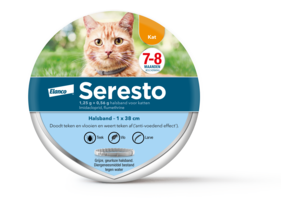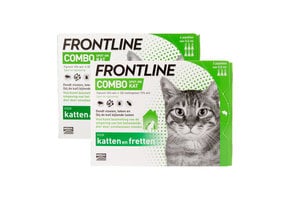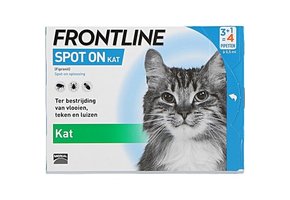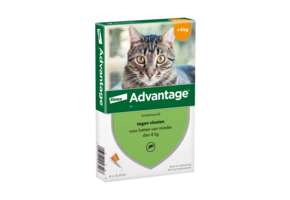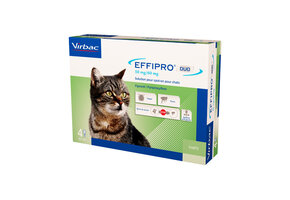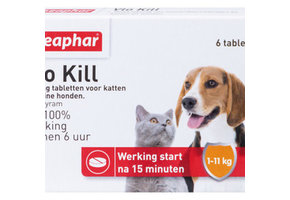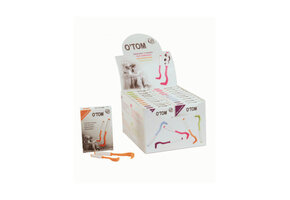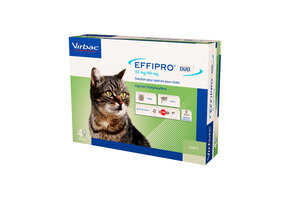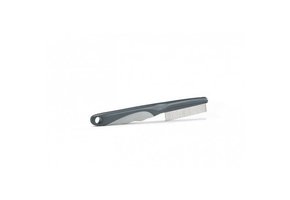There are different products for fleas and ticks for the cat. You can choose from various methods of administration, such as a collar, spray or drops (spot-on pipette). Keep in mind the age of your cat when choosing an anti-flea and/or anti-tick medicine.
Ticks and fleas are spread throughout all of Europe, so a cat always runs the risk of being bitten by fleas or ticks, small (ecto) parasites that can cause various problems. The tick bite itself is usually not painful, but diseases can be transmitted through a tick bite with possibly nasty consequences. Fleas, on the other hand, can cause skin problems in the cat. Fortunately ticks and fleas are easy to fight and prevent with the right means.
FLEAS
Fleas are small blood-sucking insects that remain on the cat once they are on it. In cats the cat flea (Ctenocephalides felis) can cause an infection. These fleas can also bite people, creating small red bumps, but they immediately fall off again. They are creatures that like to nestle in warm, sheltered places. Not surprising that cat hair is so loved by the fleas. A cat can be infected with tapeworms after eating an infected flea and kittens may even suffer from anemia by the blood sucking. That is why it is important to treat your cat against fleas as quickly as possible.
Symptoms of a fleas infection
- Itching
- Red, fiery spots (often located on the belly or inside of the hind legs)
- General anxiety
- Hair loss
- Crusts on the skin
In addition to these symptoms, it is also possible that cats get a considerable inflammation of the skin, due to the many scratches. In addition, it is also possible that cats become allergic to the saliva of the fleas, which increases the severity of the symptoms. Consult a veterinarian in case of very severe itching, scaly skin and baldness.
Fleas can transmit the following diseases to cats:
Cat Crab Disease by Bartonella
Bartonella does get into the red blood cells of cats, but it does not destroy the blood cells. Bartonella therefore usually does not cause any symptoms of disease in the cat. Cats usually do not get anemia from it. Flea poops contain a lot of cat blood, and can therefore be infected with Bartonella. People get infected with Bartonella from dirty cat nails (cat crab disease)
Mycoplasma (gives anemia)
Cats with anemia due to hemolysis (blood degradation) are often infected with Mycoplasma (there are 3 types of haemotrophic Mycoplasmas, of which Mycoplasma hemofelis is the most important).
Rickettsia
Rickettsia felis, this is primarily a danger for humans, it is uncertain whether cats will get sick.
TICKS
The tick is a small dangerous parasite that sticks to the skin of humans and mammals to indulge in blood. Over time, the tick releases again filled with blood. This cycle does not seem to be a problem in itself, but in the meantime the tick can transmit serious diseases.
Consequences of a tick bite
The best known disease that ticks can transmit in Europe is Lyme disease. A tick bite causes an infection with the Borrelia burgdorferi bacterium. Other common diseases include Babesiosis (Tick fever - Piroplasmosis), Anaplasmosis and Ehrlichia.
With cats we see the sheep tick or forest tick (Ixodes ricinus) just like with the dog. But cats also often have ticks of hedgehogs (Ixodes hexagonus) and rodents. These ticks are only in 1 to 2% infected with Babesia or Borrelia.
Ticks can infect cats with:
Babesiosis
Babesiosis, or tick fever, is a protozoal infection that is transmitted by ticks that occur in southern Europe. Cats with Babesia usually show no symptoms. Cats that are infected can sometimes be listless, do not eat, are weak and have diarrhea. Fever and jaundice are rare, but the symptoms may remain unremarkable until a later stage of disease. Often these cats are FIV or FeLV positive and also have mycoplasma.
Ehrlichiosis and Anaplasmosis
Cats with Anaplasma can develop joint inflammation, similar to the dog, but most cats don't get sick from an Anaplasma infection.
Cats with Ehrlichia can get the same symptoms as dogs with Ehrlichia.
Ehrlichiosis is caused by bacteria that get into the white blood cells of cats. Ehrlichiosis is transmitted by ticks found in Southern Europe. During the acute phase we see fever, general sickness, vomiting and anemia. During the chronic phase enlarged lymph nodes, bleeding and bruising, pale mucous membranes, thickened hind legs, red urine, eye and nose depletion, kidney damage, lameness and neurological symptoms are seen. It can take weeks to years before the chronic phase starts. Your cat appears healthy between the acute and chronic phase. The treatment of Anaplasmosis and Ehrlichiosis consists of a long-term antibiotic treatment with Doxycycline.
Furthermore can ticks trans mitBorrelia (Lyme disease), Cytauxzone, Hepatozoon andFrancisiella tularensis (tularaemia, hare plague). However it is very uncertain whether cats will get sick from those infections.
Removing a tick
It is important to regularly check your cat for ticks, for example after a walk in the woods. If you find a tick, it is best to remove it immediately with a tick hook or tweezers to prevent transmission of infections as much as possible. The faster the tick is removed, the smaller the chance of disease transmission. Are you in doubt? Then contact your veterinarian.
FLEA & TICK CONTROL
Fighting fleas is not only about killing adult fleas, but also about removing eggs, larvae and pupae in the environment, since the life cycle of the flea takes place on both the cat and the environment. That is why there are various flea control agents available.
- Spot-on products
These pesticides consist of drops that you apply to the cat's skin from a pipette. The active ingredient is absorbed into the skin's fat layer, killing the adult fleas and ticks. Fleas are often killed before they bite. Most drugs only work against adult fleas. Some substances end up in the environment through the dander of your cat, which also tackles the early stages of the flea, this happens among others with Frontline Combo and the Seresto collar. A continuous flea prevention on your cat is important, because recontamination occurs easily through young fleas from the environment. - Collars
These collars often work for a very long time because the active substance is slowly released from the collar for months. Here too the active substance ends up in the fatty layer of the skin. Direct contact with the collar should be avoided as much as possible. - Tablets
In addition, there are also anti-flea tablets. You administer this through the mouth of your cat, so that the active substance, in the pesticide, immediately ends up in the bloodstream of the cat. Because fleas suck blood on cats, the fleas will ingest the pesticide and die. We do not always have this in our assortment. - Spray the environment
As stated earlier, it is also important to treat the environment of your cat, because of the life cycle of the flea. The eggs, larvae and pupae are mainly in the environment of the cat and can sometimes be difficult to remove. Due to the persistence of environmental infection, this means thorough vacuuming, washing your cat's rugs and pillows and treating the environment with an environmental spray.
It is recommended that you read the package leaflet carefully before you administer the treatment.







